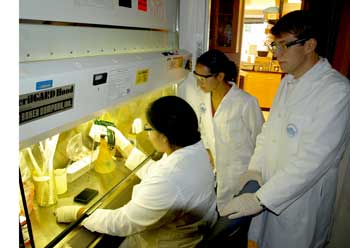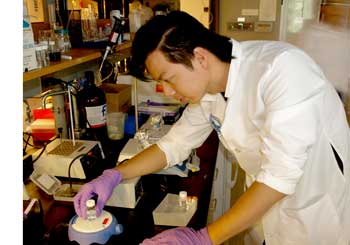
 |
|
To exert its acute cytotoxic effect, PDT entails two steps: (1) preferential localization of the photosensitizer, and (2) spatial localization of the activating light. Photosensitizers generally accumulate in tumors more than in normal tissues, mainly due to the higher permeability of the tumor microvasculature. Nano-construct formulations of PS are being used to increase accumulation within the tumor. The site directed localization, combined with selective irradiation, results in a dual selectivity that minimizes normal tissue damage. Additional selectivity is achieved by specific targeting of cell-surface molecules that are expressed at higher levels in tumor cell. Various targeting moieties including antibodies and peptides are used to deliver
either PSs or the nanoconstructs.
Vascular-Targeted PDT
 |
|
Besides directly targeting tumor tissues, PDT can be targeted to the tumor vasculature. This localization is an important factor affecting the treatment outcome of PDT. Following injection, most photosensitizers gradually extravasate from the vasculature into surrounding tissues, providing an opportunity for direct therapeutic intervention to either compartment. By using a small time interval between photosensitizer injection and light irradiation, it is possible to essentially confine the effects of PDT to the tumor vasculature. This causes vascular shutdown and tumor necrosis by lack of perfusion. We are currently investigating vascular-targeted PDT as a means to enhance the treatment outcome of pancreatic and prostate tumors with a
focus on reducing tumor growth as well as the
metastases associated with PDT.
Active Tumor Cell Targeting
The rapid proliferation of tumor cells distinguishes them from normal cells. As a result, tumor cells express distinct cell-surface molecules at higher levels, providing opportunities to target these cells selectively. The underlying principle forming the basis of this therapy is that targeted photosensitizer-conjugates selectively bind to specific tumor cells that express molecules recognized by the conjugates. Following internalization, the photosensitizers are released inside the tumor cells, whereupon light irradiation causes cell death. For the tumor cell-specific delivery of photosensitizers, our group is currently employing two strategies:
a. Photosensitizer immunoconjugates (PIC): Photoimmunotherapy uses PIC to improve the specificity of photosensitizer delivery. Our group has developed a PIC by modifying a chimeric targeting antibody (C225) with a photosensitizer. Our PIC recognizes the extracellular domain of epidermal growth factor receptor (EGFR), which is over-expressed in many tumors. The application of photoimmunotherapy in our lab is directed towards the development of new treatments for ovarian cancer.
b. Nanoconstruct mediated photosensitizer targeting: this involves the encapsulation of photosensitizers within a biodegradable polymeric nanoparticle or liposomes coated with a targeting moiety (antibody, aptamers, peptides, etc.). This approach provides not only the site-specific targeting of photosensitizer, but also increases the photosensitizer concentration at the diseased tissue. Our group is studying the application of this technology to ovarian, pancreatic, brain, and prostate cancers, as well as infectious diseases.
Targeting Infectious Diseases
a. Bacterial resistance: The emergence of clinical isolates that are resistant to many or even all standard antimicrobial chemotherapeutics provides the necessary impetus to develop treatments that are not hindered by microbial resistant mutants. Because of the acute nature of PDT killing, it is thought that microbes are unable to develop resistance to PDT. We are developing microbial-specific photosensitizers for use in PDT that exploits the b-lactamase-producing phenotype of drug resistant pathogens. Such microbe-targeted photosensitive drugs should greatly limit the degree of PDT damage to host tissues, and thus enhance treatment efficacies.
b. Rapid Fluorescence based assay for Antibiotic Efficacy: A β-lactamase sensitive photosensitizer has been constructed to result in a probe that, when cleaved (<30 min) produces a strong fluorescence signal. In the presence of antibiotic this signal strength can be can be used as a reporter, allowing for rapid screening of clinical “samples” against frontline anitobiotic.
c. Leishmaniasis: PDT is an efficient antimicrobial modality with good esthetic outcome and is used for the treatment of Cutaneous Leishmaniasis (CL). Our precise interest is in the development of selective phototherapeutic agents for improved outcome. This is achieved by: (i) determining a unique region on the Leishmania parasite and develop photosensitizers that will specifically attach to this unique site on the parasite, and (ii) designing nanotechnology-based formulations to improve photosensitizer delivery. Ultimate goal is to significantly enhance the PDT outcome and reduce its unwanted effects on healthy human tissues.
Projects
- Site-Directed PDT
- Mechanism-Based Combination Therapies
- Image-Guided Therapeutics
- Disease Model Development













